
The Big Picture
Every time a cold front sails thru town the
e-mails, tweets & FB posts arrive like clockwork. "Hey Paul, global
warming is a joke. It's cold outside!" To which I reply, "what part of
GLOBAL warming is so confusing?" It's human nature (part of our caveman
DNA?) to stare out the window and assume this is what's happening
planet-wide.
NOAA reports February 2012 to January 2013 was the warmest on record across the USA.
We've now experienced 335 consecutive months
with global temperatures exceeding the 20th century average. According
to Bill McKibben, who's coming to Minnesota next week (details on the
blog), the odds of this occurring by simple chance are less than 3.7 x
10(-99) - "a number considerably larger than the number of stars in the
universe." A natural warming cycle? Right.
Expect quiet skies thru the middle of next week,
a brisk Saturday giving way to a Monday thaw - another surge of "partly
numb" next Tuesday & Wednesday.
Storms thrive on Gulf moisture and large
north-south temperature extremes. We may have have both factors working
in our favor by late next week. It's too early to get too specific but
ECMWF model guidance is hinting a "plowable" snowfall by next Friday.
Stay tuned.
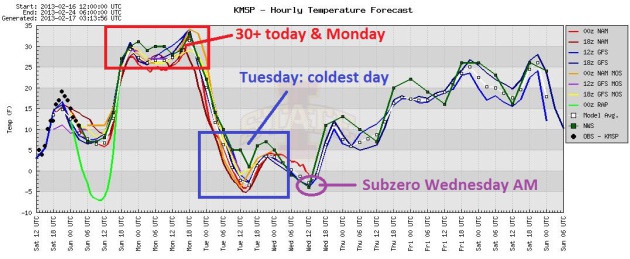
Setting The Stage For Significant Snow? After a tentative thaw Monday temperatures tumble Monday night, barely reaching +10 Tuesday, possibly dipping just below 0 Wednesday morning before struggling back up toward normal. But here's the thing. It's tough to get a (major) snowfall without significant cold air in place. The colder Minnesota is, the larger the north-south temperature gradient. If you have a big storm crossing the Rockies, southwest winds aloft and moisture bubbling out of the Gulf of Mexico? Well, then you have a chance...
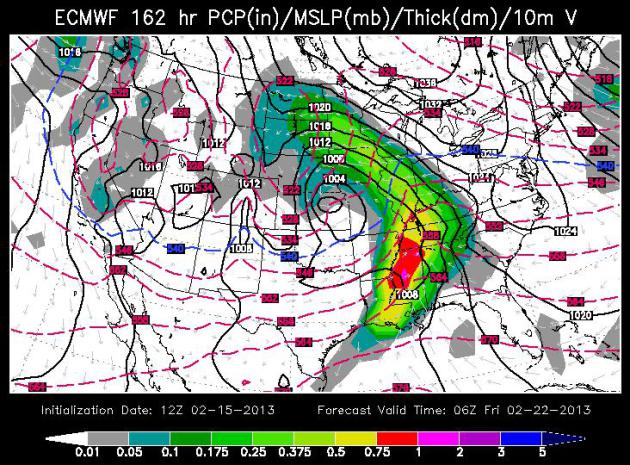
Conveyor Belt of Moisture. I can't remember much from the college days (Penn State, late 70s), but I do remember one college meteorology professor referring to this kind of scenario as a "conveyor belt", an atmospheric escalator of moisture starting in the Gulf of Mexico, and wrapping around the center of the storm as it flows toward the north/northwest. The ECMWF model forecast above is valid midnight Thursday night, showing a storm west of Kansas City, possible severe storms over the Deep South, a change from rain to snow north/west of Chicago. It's too early to panic (or get too terribly excited), but we've had a few runs/row hinting at "plowable" snow for Minnesota late Thursday into Friday.

Smells Like Snow. I want to see a few more runs, to see if there is true continuity from model to model and run to run, but the ECMWF (European) prints out .86" liquid between Thursday afternoon and Saturday morning. If this verifies, and it's all snow, it would be a pretty good pile. A lot of "ifs" in there. Deep breaths.
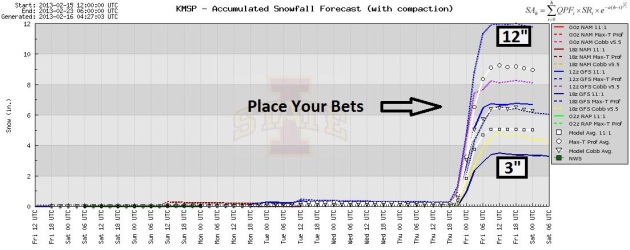
Why Meteorologists Drink. O.K. Here's your forecast for next Thursday-Friday: 3-12". Give or take. Obviously the final amount depends on the exact storm track, and how much Gulf moisture wraps around the storm and streaks into Minnesota late next week. There's still a huge divergence in amounts from the various models - confidence levels are still low.

Follow RT's LIVE UPDATES.
Eyewitness accounts of the meteorite phenomenon, handpicked by RT. Around 950 people have sought medical attention in Chelyabinsk alone because of the disaster, the region's governor Mikhail Yurevich told RIA Novosti. Over 110 of them have been hospitalized and two of them are in heavy condition. Among the injured there are 159 children, Emergency ministry reported. Army units found three meteorite debris impact sites, two of which are in an area near Chebarkul Lake, west of Chelyabinsk. The third site was found some 80 kilometers further to the northwest, near the town of Zlatoust. One of the fragments that struck near Chebarkul left a crater six meters in diameter."

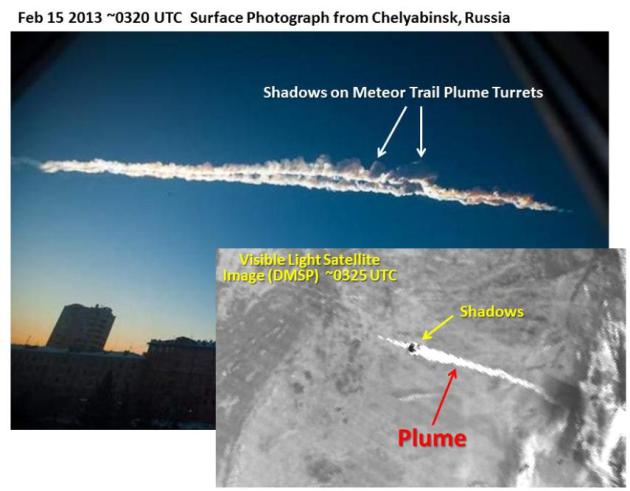
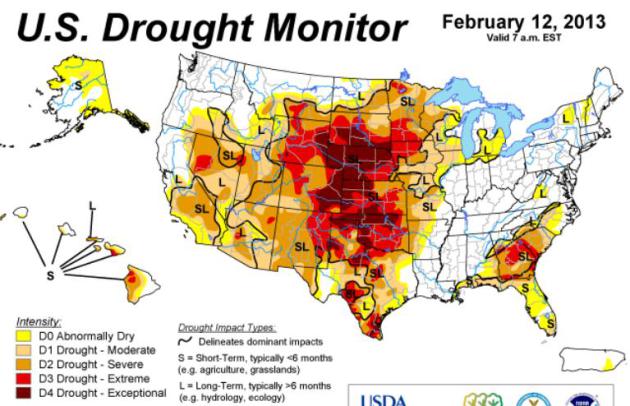
- Overall U.S. drought coverage decreased to 55.73% of the contiguous U.S., down 1.11% from last week and down 5.36% since the beginning of the year. The decrease came on the strength of heavy rain across the South and some snow in the upper Midwest.
- The portion of the contiguous U.S. in the worst category D4, or exceptional drought dipped nearly one-quarter of a percentage point (0.24%) to 6.61%. D4 coverage has ranged from 5 to 7% for 27 consecutive weeks (August 14, 2012 February 12, 2013).
- The percent of hay in drought (57%) fell two percentage points, while winter wheat in drought was unchanged at 59%. Cattle in drought (67%) fell one percentage point."

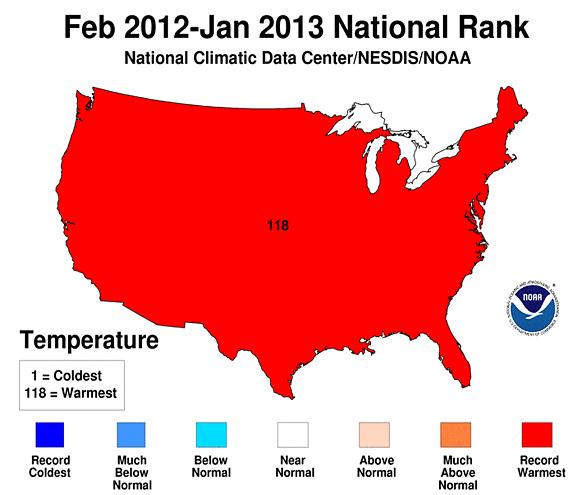
Graphic above: NCDC, National Climatic Data Center.
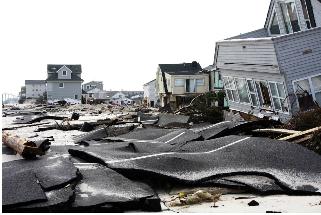
Photo credit: "Sandy damage in Ortley Beach, N.J. on Nov. 10, 2012." Photo: N.J. Governor's Office/Tim Larsen.

FCC Tells TV Stations To Secure EAS Equipment After Fake Zombie Alerts. And my favorite story of the day, the FCC actually reminding television stations that the equipment that generates emergency messages "This Is A Test" may be vulnerable to hacking from overseas - cyber hanky panky capable of issuing a (fake!) Zombie Alert. As opposed to a real Zombie Alert. TVSpy explains: "The FCC is telling stations to “take immediate action” to secure their Emergency Alert System equipment after hackers took control of the system at several stations to broadcast warnings of an imminent zombie attack. FTV Live has the full memo from the FCC:
Urgent Advisory: Immediate actions to be taken regarding CAP EAS device security.
"All EAS Participants are required to take immediate action to secure their CAP EAS equipment, including resetting passwords, and ensuring CAP EAS equipment is secured behind properly configured firewalls and other defensive measures. All CAP EAS equipment manufacturer models are included in this advisory..."
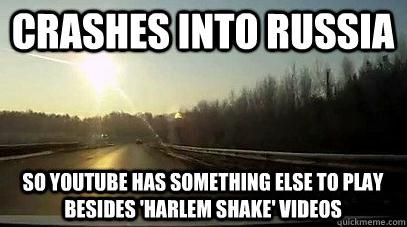


A Logical Reaction To 2.5 Feet Of Snow. I might be crying too - this photo taken somewhere in New England last weekend, courtesy of The Chive. Perfect.
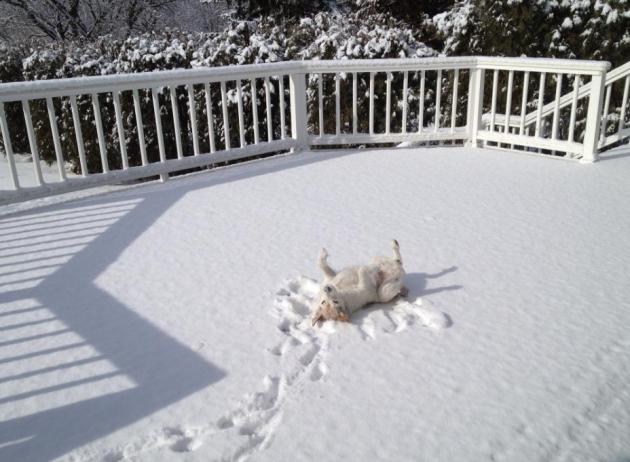
Doggie Snow Angels? Hey, why not? That's "Willie", Heidi Rusch's amazing Jack Russel, enjoying a fresh snowfall from Thursday's clipper. This one photo brightened an otherwise ho-hum Friday for me.
Climate Stories...
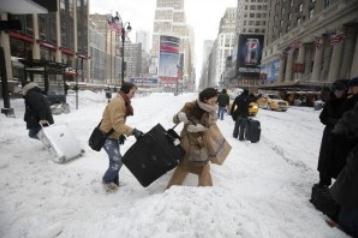
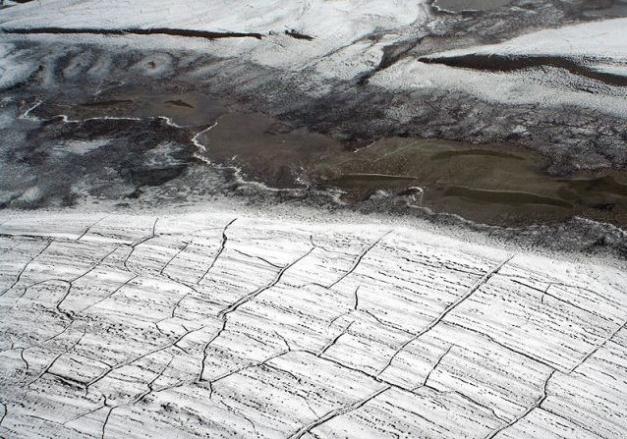
Photo credit above: "Crack patterns in Arctic permafrost as viewed from a helicopter." Credit: Brocken Inaglory/cc by 3.0
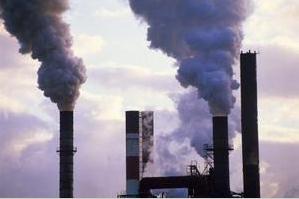
Photo credit: "Human-emitted greenhouse gases are a leading cause of global warming."

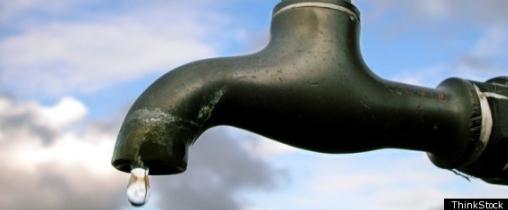
Smart Water; New Jobs. Water, not gas or oil, will quickly become the most precious natural resource in the 21st century; here's an excerpt of an article at ScienceBlogs: "Invest in the future. And especially, invest in sustainable, effective job creation in the water sector. The result will be millions of new jobs – a significant result. That is the key message from a new analysis just released today by the Pacific Institute on sustainable water jobs in the United States. That study, Sustainable Water Jobs: A National Assessment of Water-Related Green Job Opportunities, finds that proactive investments increasing efficient water use, improving water quality, expanding smart water treatment and re-use, and more will address growing problems associated with failing water infrastructure, deteriorating water quality, severe drought, and flooding, as well as create jobs in a wide range of professions. The study identifies 136 different kinds of jobs at all levels of skill: from plumbers to landscapers, from technology specialists and engineers to irrigation experts. Thirty-seven of these job types are also projected to have high growth in the overall economy, with each offering more than 100,000 job openings across the country by 2020. That’s millions of new jobs..."